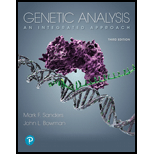
To analyze:
A cross between wild type soybean plants with pure breeding soybean plant having recessive
| Phenotype | Number |
| Pale | |
| Pale, oval | |
| Pale, short | |
| Pale, oval, short | |
| Oval | |
| Oval, short | |
| Short | |
| Wild type | |
| Total |
By using the above information,
Predict alleles present on the homologous chromosome of the parental wild type soybean plant.
Determine the recombinant frequency between the adjacent genes on the chromosome.
Calculate the interference value for the given data.
Introduction:
The cross which involves the inheritance of three genes is called the trihybrid cross. According to the law of independent assortment, each allele separates from the other independently. Therefore, in trihybrid cross, there are different gametes produced, out of which two gametes are called parental gametes or non-recombinant and four are produced from single crossover and two produced from double crossover.
The parental gametes are produced during meiosis and do not undergo crossing over. Therefore, they match the parental genotype. Hence the different arrangement of dominant and recessive allele occurs at the chromosome. Parental gametes are present at the homologous chromosome.
Non-recombinant gametes account for high frequency than the recombinant gametes.
The recombination frequency depends upon the distance between the two genes. The recombination frequency suggests that if the distance between two genes is more, then crossing over in the genes occurs at a high rate. If the linked gene has a high recombination frequency, then they are more distant from one another.
The recombination frequency (r) of the syntenic gene is calculated by the formula-
Interference (I) value is used to predict the double crossover (expected but not produced). Interference is given as, I = 1- c …where c is the coefficient of coincidence.
If the I < 0, the condition is called negative interference, and if
Want to see the full answer?
Check out a sample textbook solution
Chapter 5 Solutions
Genetic Analysis: An Integrated Approach (3rd Edition)
- Can you described the image? Can you explain the question as well their answer and how to get to an answer to an problem like this?arrow_forwardglg 112 mid unit assignment Identifying melting processesarrow_forwardGive only the mode of inheritance consistent with all three pedigrees and only two reasons that support this, nothing more, (it shouldn't take too long)arrow_forward
- Oarrow_forwardDescribe the principle of homeostasis.arrow_forwardExplain how the hormones of the glands listed below travel around the body to target organs and tissues : Pituitary gland Hypothalamus Thyroid Parathyroid Adrenal Pineal Pancreas(islets of langerhans) Gonads (testes and ovaries) Placentaarrow_forward
- What are the functions of the hormones produced in the glands listed below: Pituitary gland Hypothalamus Thyroid Parathyroid Adrenal Pineal Pancreas(islets of langerhans) Gonads (testes and ovaries) Placentaarrow_forwardDescribe the hormones produced in the glands listed below: Pituitary gland Hypothalamus Thyroid Parathyroid Adrenal Pineal Pancreas(islets of langerhans) Gonads (testes and ovaries) Placentaarrow_forwardPlease help me calculate drug dosage from the following information: Patient weight: 35 pounds, so 15.9 kilograms (got this by dividing 35 pounds by 2.2 kilograms) Drug dose: 0.05mg/kg Drug concentration: 2mg/mLarrow_forward
- A 25-year-old woman presents to the emergency department with a 2-day history of fever, chills, severe headache, and confusion. She recently returned from a trip to sub-Saharan Africa, where she did not take malaria prophylaxis. On examination, she is febrile (39.8°C/103.6°F) and hypotensive. Laboratory studies reveal hemoglobin of 8.0 g/dL, platelet count of 50,000/μL, and evidence of hemoglobinuria. A peripheral blood smear shows ring forms and banana-shaped gametocytes. Which of the following Plasmodium species is most likely responsible for her severe symptoms? A. Plasmodium vivax B. Plasmodium ovale C. Plasmodium malariae D. Plasmodium falciparumarrow_forwardStandard Concentration (caffeine) mg/L Absorbance Reading 10 0.322 20 0.697 40 1.535 60 2.520 80 3.100arrow_forwardPlease draw in the missing answer, thank youarrow_forward
 Concepts of BiologyBiologyISBN:9781938168116Author:Samantha Fowler, Rebecca Roush, James WisePublisher:OpenStax College
Concepts of BiologyBiologyISBN:9781938168116Author:Samantha Fowler, Rebecca Roush, James WisePublisher:OpenStax College Biology (MindTap Course List)BiologyISBN:9781337392938Author:Eldra Solomon, Charles Martin, Diana W. Martin, Linda R. BergPublisher:Cengage Learning
Biology (MindTap Course List)BiologyISBN:9781337392938Author:Eldra Solomon, Charles Martin, Diana W. Martin, Linda R. BergPublisher:Cengage Learning Human Heredity: Principles and Issues (MindTap Co...BiologyISBN:9781305251052Author:Michael CummingsPublisher:Cengage Learning
Human Heredity: Principles and Issues (MindTap Co...BiologyISBN:9781305251052Author:Michael CummingsPublisher:Cengage Learning Biology Today and Tomorrow without Physiology (Mi...BiologyISBN:9781305117396Author:Cecie Starr, Christine Evers, Lisa StarrPublisher:Cengage Learning
Biology Today and Tomorrow without Physiology (Mi...BiologyISBN:9781305117396Author:Cecie Starr, Christine Evers, Lisa StarrPublisher:Cengage Learning
 Human Biology (MindTap Course List)BiologyISBN:9781305112100Author:Cecie Starr, Beverly McMillanPublisher:Cengage Learning
Human Biology (MindTap Course List)BiologyISBN:9781305112100Author:Cecie Starr, Beverly McMillanPublisher:Cengage Learning





